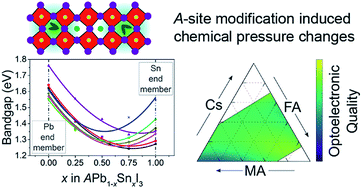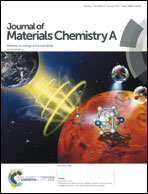On understanding bandgap bowing and optoelectronic quality in Pb–Sn alloy hybrid perovskites†
Abstract
High quality small-bandgap hybrid perovskites (AMX3 with M = Pb1−xSnx) are pivotal for all-perovskite multi-junction photovoltaics. The bandgap of these alloys significantly deviates from the linear interpolation between the bandgaps of APbI3 and ASnI3 for all A-site cations examined thus far. This non-linearity of the bandgap with composition is referred to as bandgap bowing. Here, we explore a wide-range of A-site compositions to understand bandgap bowing and identify the optimal Pb–Sn alloy composition. Optical and structural investigations of different APb1−xSnxI3 alloys reveal that the bandgap bowing is correlated with the extent of microstrain in their respective APbI3 compounds. We discover that bandgap bowing in APb1−xSnxI3 alloys is primarily due to local structural relaxation effects (changes in bond angles and lengths) that result from the size, shape, and charge distribution of the cations on the A-site, and that these effects are intimately coupled with chemical effects (intermixing of atomic orbitals) that result from changes in the M-site. The choice of X-site also impacts bandgap bowing because of the X-site anions' influence on local structural relaxation and chemical effects. Further, we extend these results to provide a general rationale for the origin and modulation of bandgap bowing in HP alloys. Subsequently, using high-throughput combinational spray coating and photoluminescence analysis, we find that ternary combinations of methylammonium (MA), formamidinium (FA), and cesium (Cs) are beneficial to improve the optoelectronic quality of APb1−xSnxI3 alloys. The optimal composition, (MA0.24FA0.61Cs0.15)(Pb0.35Sn0.65I3)I3 has a desirable low bandgap (1.23 eV) and high optoelectronic quality (achieving 86% of the detailed balance limit quasi-Fermi level splitting). This study provides valuable insights regarding bandgap evolution in HP alloys and the optimal small-bandgap absorber composition desired for next-generation HP tandems.



 Please wait while we load your content...
Please wait while we load your content...